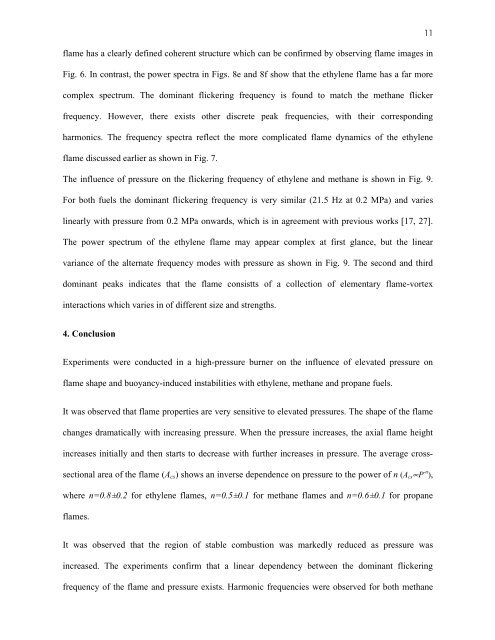FUEL VARIABILITY EFFECTS ON DIFFUSION FLAMES A
FUEL VARIABILITY EFFECTS ON DIFFUSION FLAMES A
FUEL VARIABILITY EFFECTS ON DIFFUSION FLAMES A
You also want an ePaper? Increase the reach of your titles
YUMPU automatically turns print PDFs into web optimized ePapers that Google loves.
flame has a clearly defined coherent structure which can be confirmed by observing flame images in<br />
Fig. 6. In contrast, the power spectra in Figs. 8e and 8f show that the ethylene flame has a far more<br />
complex spectrum. The dominant flickering frequency is found to match the methane flicker<br />
frequency. However, there exists other discrete peak frequencies, with their corresponding<br />
harmonics. The frequency spectra reflect the more complicated flame dynamics of the ethylene<br />
flame discussed earlier as shown in Fig. 7.<br />
The influence of pressure on the flickering frequency of ethylene and methane is shown in Fig. 9.<br />
For both fuels the dominant flickering frequency is very similar (21.5 Hz at 0.2 MPa) and varies<br />
linearly with pressure from 0.2 MPa onwards, which is in agreement with previous works [17, 27].<br />
The power spectrum of the ethylene flame may appear complex at first glance, but the linear<br />
variance of the alternate frequency modes with pressure as shown in Fig. 9. The second and third<br />
dominant peaks indicates that the flame consistts of a collection of elementary flame-vortex<br />
interactions which varies in of different size and strengths.<br />
4. Conclusion<br />
Experiments were conducted in a high-pressure burner on the influence of elevated pressure on<br />
flame shape and buoyancy-induced instabilities with ethylene, methane and propane fuels.<br />
It was observed that flame properties are very sensitive to elevated pressures. The shape of the flame<br />
changes dramatically with increasing pressure. When the pressure increases, the axial flame height<br />
increases initially and then starts to decrease with further increases in pressure. The average cross-<br />
sectional area of the flame (Acs) shows an inverse dependence on pressure to the power of n (Acs∝P -n ),<br />
where n=0.8±0.2 for ethylene flames, n=0.5±0.1 for methane flames and n=0.6±0.1 for propane<br />
flames.<br />
It was observed that the region of stable combustion was markedly reduced as pressure was<br />
increased. The experiments confirm that a linear dependency between the dominant flickering<br />
frequency of the flame and pressure exists. Harmonic frequencies were observed for both methane<br />
11
















